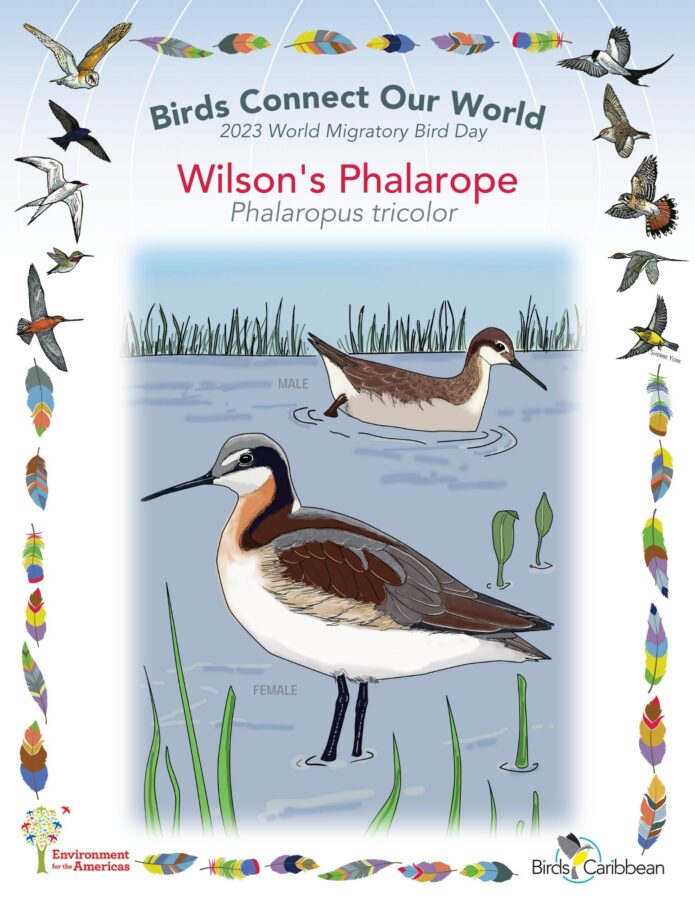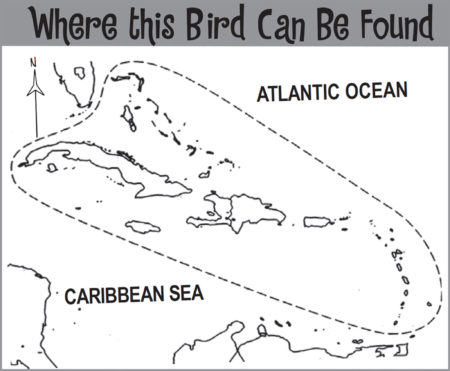Celebrate World Migratory Bird Day (WMBD) with us in 2023! This year’s theme is “Water: Sustaining Bird Life”. Have fun learning about a new migratory bird every day. We have coloring pages, puzzles, activities, and more. Download for free and enjoy nature with your family at home.
Migratory Bird of the Day: Wilson’s Phalarope
Each summer, west of the Mississippi, the Wilson’s Phalarope gathers in enormous flocks on the salt lakes of the western United States. Birders and conservationists are captivated by the species’ distinctive field marks, habitat preferences, feeding habits, and interesting natural history—including a departure from normal breeding habits!
The Wilson’s Phalarope is a small (22–24 cm in length), aquatic shorebird, with a needle-like bill and a white rump and underparts. Wilson’s Phalaropes exhibit sexual dimorphism (where males and females look very different from each other). Interestingly, females are larger and much more colorful than their male counterparts. In breeding plumage, females display a beautiful reddish-brown neck and back, contrasting with a white belly. Males, on the other hand, are more subdued in appearance, featuring a drabber overall coloration. Regardless of sex, both genders boast a distinctive white stripe running down the center of their long necks and black eye masks. During the non-breeding season, both males and females sport a more subdued plumage, of pale gray above and white below.
The Wilson’s Phalarope has a diverse and widespread distribution; its breeding range spans from western Canada down to the western United States. They breed in a range of wetland habitats, including lakes, ponds, and marshes. After laying eggs, the female typically departs, leaving the male to incubate the eggs and care for the young. This unique reversal of traditional gender roles, called “polyandry,” is an intriguing aspect of their breeding biology.
During the non-breeding season, these remarkable birds undertake impressive migrations that lead them to coastal areas of South America, particularly along the western coast. As part of their migratory route, they may also travel through the Caribbean. Our islands thus provide essential stopover points where these birds can rest and feed before continuing their long migrations.
One of the most remarkable aspects of the Wilson’s Phalarope is its feeding behavior. They are adept at foraging in shallow waters, using their long, slender bills to peck at the surface. One can observe them swimming in small, rapid, circular motions. This unique swimming behavior creates a small vortex, or a whirlpool, that brings up aquatic invertebrates from the depths, providing a rich food source. Terrestrial invertebrates are also consumed.
Currently, Wilson’s Phalaropes are classified as a species of Least Concern on the IUCN Red List, indicating that they are not currently facing significant conservation threats. However, like many bird species, they are not immune to potential threats. Habitat loss due to urban development and agricultural expansion remains a concern. Additionally, disturbances to breeding and foraging areas, pollution of wetlands, and climate change induced shifts in their preferred habitats could potentially impact their populations.
You can help conserve Wilson’s Phalaropes and other wetland-dependent bird species by:
- Supporting wetland protection and sustainable land use in your region.
- Participating in citizen science by joining eBird! The more information that is available to researchers, the better they can help protect these precious birds.
- Helping raise awareness and let people know about the importance of wetlands for birds and people!
Learn more about this species, including its range, photos, and calls here.
Thanks to Susan Davis for the text and Christine Elder for the lovely illustration!
Color in the Wilson’s Phalarope
Download the Migratory Birds of the Day Coloring Page! Use the picture above and the photos on this page as your guide, or look up pictures of the bird online or in a bird field guide if you have one. Share your colored-in page with us by posting it online and tagging us @BirdsCaribbean #WMBD2023Carib
Listen to the calls of the Wilson’s Phalarope
Wilson’s Phalaropes make abrupt nasal-sounding calls to each other. These are made both as courtship and contact calls.
Puzzles of the Day
Click on the images below to do the puzzle. You can make the puzzle as easy or as hard as you like—for example, 6, 8, or 12 pieces for young children, and all the way up to 1,024 pieces for those that are up for a challenge!
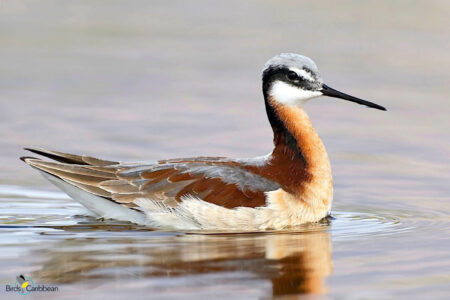
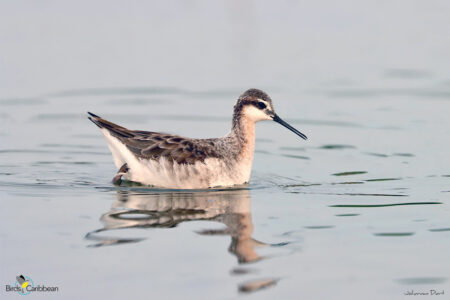
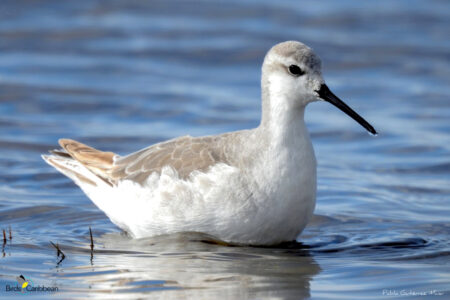
Activity of the Day
![]() FOR KIDS: Wilson’s Phalaropes make epic journeys south every year on migration! They start heading towards the Caribbean and South America in July, before the weather gets too cold and food becomes hard to find. They don’t make this trip all in one go; they make some stops along the way to rest, molt out of their breeding plumage, and take on more food. They can eat so much on some of these stops that they double their body weight!
FOR KIDS: Wilson’s Phalaropes make epic journeys south every year on migration! They start heading towards the Caribbean and South America in July, before the weather gets too cold and food becomes hard to find. They don’t make this trip all in one go; they make some stops along the way to rest, molt out of their breeding plumage, and take on more food. They can eat so much on some of these stops that they double their body weight!
Why not ‘Follow the Phalarope’ in our fun activity? You will learn how to map the migration routes of three Wilson’s Phalaropes all the way from North America to islands in the Caribbean! You can find the instructions and worksheet here.
FOR KIDS AND ADULTS: Enjoy these videos, by Don DesJardin, of Wilson’s Phalaropes foraging in the Wild! In the first video you can see the different plumages of the brightly colored female and duller male. In the second can see the ‘spinning’ technique these birds often use when feeding.

